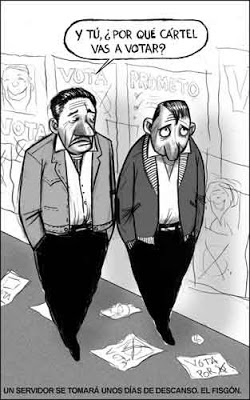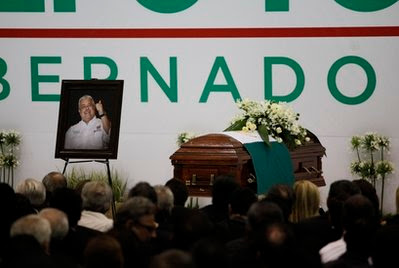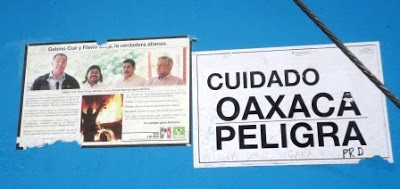‘United Cartels’ are big winners in
Mexico’s Super Sunday elections
By John Ross / The Rag Blog / July 9, 2010
See ‘The people of Oaxaca speak’ by Victor Raul Martinez Vasquez, Below.
MEXICO CITY — The cartoon in the morning left daily La Jornada summed up the July 4th Super Sunday election here: two citizens are picking their way through the debris of the balloting in which a dozen governorships are up for grabs. “Which cartel are you voting for?” one asks the other.
The cartoon, drawn by “El Fisgon” (“The Busybody”), one of the nation’s most acute political commentators, encapsulated the question many Mexican voters have been puzzling over in the heat of a campaign during which front-running candidates have been gunned down, the victims of apparent drug war hits, and others have wound up behind bars, charged with crimes related to Mexico’s flourishing drug trade.
In readjusted figures released by Mexican drug war officials last week, more than 25,000 citizens have been slain since December 2006 when President Felipe Calderon declared an ill-advised war on the drug cartels. The number of dead and their survivors constitutes a substantial voting block.
Never before have the cartels so publicly intervened in a Mexican election. On June 28th, less than a week before Super Sunday, unidentified gunmen cut down the gubernatorial candidate for the once and future ruling PRI party in Tamaulipas, a border state wracked by protracted violence between the Gulf Cartel and the gang’s former enforcers, the Zetas.
The assassination of Rodolfo Torre Cantu, a shoo-in for the state house, was the highest profile assassination of a Mexican politico since Luis Donaldo Colosio, the PRI presidential candidate, was whacked in Tijuana in 1994, a crime sometimes ascribed to lingering conflicts within the party over his candidacy. State and federal investigators discount political rivalry as being the cause of Torre Cantu’s death.
What is dead certain is that the murder of Torre Cantu, the Tamaulipas Secretary of Public Health, was not a case of mistaken identity — when he was ambushed on an access road to the municipal airport in the state capitol of Ciudad Victoria, the vehicle in which he was riding was plastered with an enormous portrait of the now-deceased politician.
Because the killing came so close to Election Day, new ballots could not be printed in time and Dr. Torre Cantu’s name appeared at the top of the PRI ticket. On June 29th, in an emergency session convened by PRI party president Beatriz Paredes, 16 PRI governors selected the dead candidate’s brother, Eligio, a civil engineer with no political experience, to replace him should the party win the state house July 4th.
Although no arrests have been forthcoming, one witness purportedly testified that one of the killers’ getaway cars was emblazoned with a “Z” — an indication that the Zetas bear responsibility for taking out the candidate, a message of which the new governor will no doubt take note. PRI officials scoff at reports that the Zetas were tipped off by campaign workers infiltrated by the drug gang to keep tabs on Dr. Torre Cantu’s whereabouts.
The PRIista was the second candidate to be cut down in Tamaulipas in the run-up to July 4th. On May 13th, Manuel Guajardo, the right-wing PAN hopeful for municipal president of Valle Hermosa was assassinated outside that northern Tamaulipas town said to be the home base of Heberto Lasca Lasca, “El Lascas,” the capo of one wing of the Zetas.
All over the state, candidates for municipal and state offices in addition to an estimated 700 election workers dropped out of the July 4th vote taking despite promises that their safety would be guaranteed by military escorts.
“The United Cartels,” a handle ascribed to various drug gangs in a “narco-manta” (banner) posted in Matamoros on the border prior to the July 4th election, “are now dictating which candidates the parties can run for office,” wrote Proceso magazine correspondent Gerardo Albarron de Alba in an election curtain raiser from Tamaulipas.
Chihuahua, the nation’s largest state, is another border entity where the campaign trail was drenched in blood. 1300 Chihuahuans, more than half of them in Ciudad Juarez, have lost their lives since the first of the year, including a pair of candidates for municipal president in the Valley of Juarez outside that conflictive border crossing. Many other candidates were warned not to campaign. Opponents tied Hector Murguia, PRI candidate for mayor of Ciudad Juarez, to “La Linea,” enforcers for the Juarez Cartel, which is locked in an intractable battle with Chapo Guzman’s Pacific Cartel for control of the Juarez “plaza.”
Five nights before the balloting, an assistant Chihuahua attorney general was assassinated on a public street in Juarez. On election eve, a freshly severed head was installed on Murguia’s front lawn. Early morning voters July 4th discovered four corpses hung from
the city’s pedestrian bridges.
Similarly, next door in Durango where the PAN and the PRI battled down to the wire for the governor’s seat, bullets replaced ballots as the Zetas-Chapos gang war rages throughout the state. In the week before the election, 10 were cut down at a Durango drug treatment center — such facilities are often used by the drug gangs as safe houses for their pistoleros.
Next door in Sinaloa, the cradle of Mexican drug culture, which also selected a new governor July 4th, the headquarters of the three major political parties were firebombed by unknowns. At the closing campaign rally for PRI gubernatorial candidate Jesus Vizcarra, a small plane dumped thousands of leaflets on the diehards depicting the candidate in the company of “El Mayo” Zembada, number two in Chapo‘s cartel — the leaflets were slugged “its all in the family.”
At the other end of the country in Quintana Roo on the Yucatan peninsula, the left-coalition candidate for governor, “Greg” Sanchez was removed from the ballot after he was formally indicted on charges of laundering vast amounts of money through private bank accounts. Sanchez, an evangelical preacher and former mayor of the luxury resort city of Cancun, explained the discrepancies as “an accounting error.” The ex-left candidate reportedly owns a ranch on the Chiapas-Guatemalan border through which hundreds of undocumented Cubans (Sanchez’s wife is a Cubana) and tons of Colombian cocaine are guaranteed safe passage.
Sanchez, currently locked up in a maximum-security federal prison, is the second big-time Quintana Roo politico to be collared by Mexican authorities for drug crimes. Mario Villanueva, governor between 1993 and 1999, was convicted of transforming that Caribbean state into a free duty port for Colombian cocaine cartels, and is currently fighting extradition to the U.S.
But perhaps the bitterest face-off this July 4th had more to do with presidential elections upcoming in 2012 than with the “United Cartel’s” campaign to secure political space. In the conflictive southern state of Oaxaca [see story below], the shoot-out between outgoing governor Ulises Ruiz’s successor and right-left coalition candidate Gabino Cue had already cost seven lives by Election Day. Ruiz, whose police state tactics triggered civic rebellion in 2006 during which dozens of his opponents were executed by roving death squads, is in line to take over the presidency of the PRI once the smoke has cleared back home.
Oaxaca is one of five states in which the left-center PRD and the right-wing PAN affiliated in a joint effort to push back the PRI July 4th, an arrangement of bizarre bedfellows brokered by Manuel Camacho Solis, ex-Mexico City mayor and former PRI bigwig who is now a PRD honcho. Just four years ago in the 2006 presidential face-off, PANista Felipe Calderon was awarded a fraud-saturated victory over the PRD’s Andres Manuel Lopez Obrador and the two parties have been at each other’s throats ever since.
The PRD-PAN coalition claimed broad victory in Sunday’s election in Oaxaca winning both the governorship and 24 out of 26 seats in the state congress.
Despite the painful loss of his successor Eviel Perez, Ulises Ruiz is banking on becoming the next national president of the PRI and heir to the current Boss of all Bosses Beatriz Paredes, a slot that would put him in an advantageous position to call the shots in the 2012 “presidenciales.”
Paredes, the most prominent woman politician in the land, who is always garbed in one of her trademark voluminous “huipiles” or colorful Indian muumuus (she brags that she has never worn the same one twice), has designs on the 2012 PRI presidential nomination and appears to have struck a deal with her party’s senate leader, Manlio Fabio Beltrones (“Don Beltrones“) to derail the ambitions of current frontrunner Enrique Pena Nieto, the short but photogenic governor of Mexico state who is backed by the TV giant Televisa.
Which of the candidates will win the support of which drug cartel is expected to be the deciding factor in who wins the nod.
The Super Sunday electoral fiesta was billed as the last stop on the electoral calendar before 2012. Even by Mexican standards, the July 4th balloting was the most devious stand-off in recent Mexican electoral history, marked by tapped telephone conversations suggesting the illicit distribution of state funds in Puebla, Oaxaca, and Veracruz, phony polling, the wholesale bribery of the already bought-and-sold-mainstream media, homophobia (a doctored photo of the PRD-PAN candidate in Puebla in drag), lie detector interrogations, demands that candidates submit to “anti-doping” tests, and robust narco-violence.
In a maneuver to soft peddle the role of the PRI, a party that mismanaged Mexico for seven decades of cradle-to-the-grave corruption, the Institutional Revolutionary Party has aligned itself with the Mexican Green Ecologist Party (PVEM) whose only attachment to the greening of Mexico is the color of the money, and in some states to the PANAL, a vanity party owned by teachers’ union dominatrix Elba Esther Gordillo. The PRI-led coalitions masqued their true identities behind such titles as “Para Cambiar Veracruz” (“To Change Veracruz”), “Zacatecas First!”, and “Todos Tamaulipas” (“All Tamaulipas.”)
Not to be outdone, the PRD-PAN coalitions and PRD alliances with other left parties like the Party of Labor (PT) and Democratic Convergence hid behind similar benign sounding front groups and it may be weeks before the real winners can be separated from the losers.
Nonetheless, preliminary results signal a clean sweep for the PRI in four out of five northern narco states, including Baja California which only selected municipal presidents and a local congress July 4th. The one-time ruling party also appears to have sustained the victorious roll that won it a majority in both houses of congress in the 2009 mid-terms over Calderon’s battered PAN with big wins in Quintana Roo, Hidalgo, Tlaxcala, Aguascalientes, and Zacatecas — the only state taken from the PRD camp (and the only one governed by a woman).
Prolonged post-electoral struggle in Veracruz, where the PRI margin of victory is being tenaciously contested by the PAN, is predicted. Oaxaca, Puebla, and Sinaloa, three states in which the PAN and the PRD joined forces, will be governed by the coalition — although whether the left PRD will actually have a significant voice in administrating the affairs of the states is dubious.
But the big winner, as is so often the case, was the Party of No with just under half the eligible voters failing to turn out at the polls, many because of fears of threatened narco-violence such as in Chihuahua where only 30% of the electorate showed up. In Ciudad Juarez, thousands of citizens wrote in ballots protesting Calderon’s on-going drug war.
Corporate media on both sides of the border framed the Super Sunday shebang as a referendum on Felipe Calderon’s failing war on the drug cartels. Assuming this to be the case, guess who lost?
[John Ross has lived in Mexico City’s old quarter for the past quarter of a century. His latest opus El Monstruo: Dread and Redemption in Mexico City (“gritty and pulsating” – The New York Post) chronicles this passage. He is currently at home, contemplating life after the World Cup. You are invited to send your complaints to johnross@igc.org.]
The people of Oaxaca speak
By Victor Raul Martinez Vasquez / July 6, 2010
When the people rise up,
demand bread, liberty, land,
the powerful tremble
from the mountains to the sea.In critical historical moments, the people teach. Some say the voice of the people is the voice of God. The people of Oaxaca have now spoken to the authoritarian regime which has caused so much suffering. In spite of that regime’s dirty war, fascist propaganda, alarming waste of public resources and the climate of terror it created in hopes of controlling votes, the people of Oaxaca, as they did in 2006, rose up and voted overwhelmingly against those it judged to be unworthy.
The elections of 2010 are historic and for many reasons:
They’re the first elections in which the PRI government has been defeated in 81 years — first as the Partido Nacional Revolucionaria (PNR), later as the Partido de la Revolucion Mexicana (PRM) and, finally, as the Partido Revolucionario Institutional (PRI).
And Gabino Cue, the first Governor of Oaxaca not drawn from the ranks of PRI, won by a margin of more than 100,000 votes or 10% more than that of PRI’s candidate, Eviel Perez Magana. Cue’s legitimacy as the new Governor is therefore beyond dispute. It should at the same time be recognized that Eviel Perez contributed to the legitimacy of Cue’s victory by openly accepting it. Cue should not waste the “democratic bonus” he now enjoys.
The vote is also historic because PRI lost control of the state Congress. According to preliminary analyses, PRI will have about 14 of the 42 deputies, el PAN 13 or 14 and PRD 10 or 11 which means the coalition of PRD and PAN will have a majority permitting it to dismantle the authoritarian legal structures now suffered by the people by writing a new Constitution or by drafting a series of radical constitutional reforms that create a more democratic juridical system. The new deputies must now seize this opportunity given and expected of them by the people.
The vote is historic because the people of Oaxaca moved beyond abstentionism. Some 56% of the people voted in contrast to participation at the national level of 40%. The people knew a historic moment had been reached and now expect those elected to fulfill their new and demanding responsibilities.
The people have now achieved what the past legislature refused to do. They made a political judgment against Ulises Ruiz and pronounced him guilty of the violation of human rights and inexcusable conduct in the successor to the Governor’s office. The people have voted and the people have condemned him.
The political dynamics in Oaxaca have shifted to a new place, a different place in which all the repercussions of this election cannot yet be known. We are involved now in a process that began years ago. The result of the current elections are part of a much longer historic process whose most recent stages were reached in 2004 and 2006. The PRI government failed to understand what was going on during those years and gave the people more of the same: corruption, repression and lawlessness, arrogance, lies and defamations.
An immediate result of this election is that the PRI political class is now in the opposition and without the generous help of the government in power its political weight in the state will certainly change. Gabino Cue has no desire to eliminate PRI. Revenge is not on his agenda and he speaks of reconciliation. At the same time, the people who elected Cue do expect justice to be done by the Governor they put in office.
— Source / Noticias de Oaxaca
Thanks to Val Liveoak /The Rag Blog




















